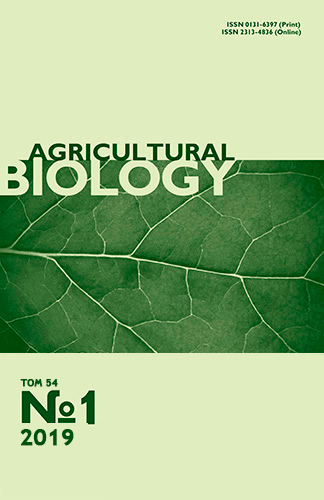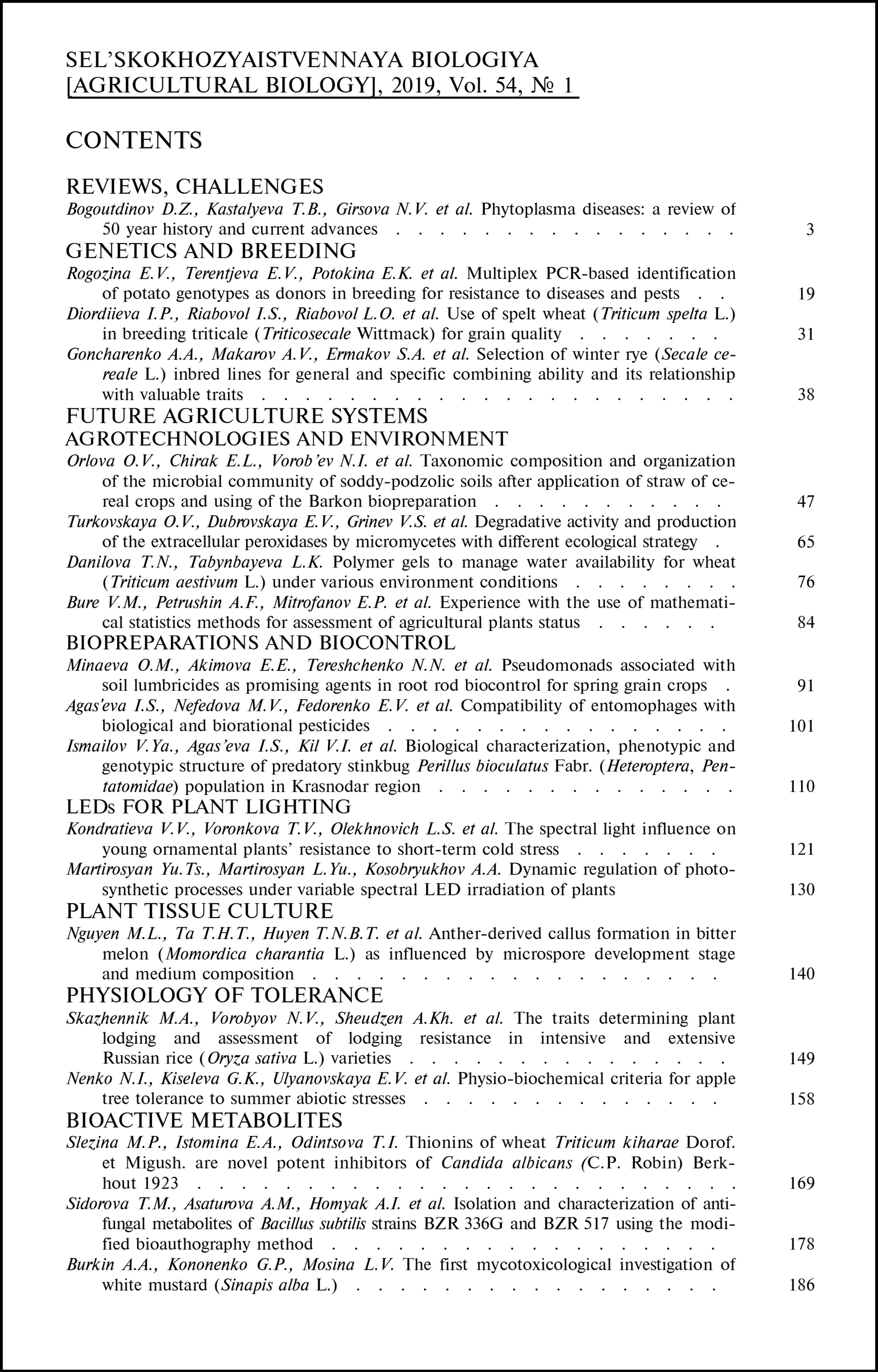doi: 10.15389/agrobiology.2019.1.130eng
UDC 635.21:581.132:581.174.1:631.588.5
Acknowledgements:
The work was performed in the framework of state assignment (No. 0574-2014-0009)
DYNAMIC REGULATION OF PHOTOSYNTHETIC PROCESSES
UNDER VARIABLE SPECTRAL LED IRRADIATION OF PLANTS
Yu.Ts. Martirosyan1, 2, L.Yu. Martirosyan1, 2, A.A. Kosobryukhov1, 3
1All-Russian Research Institute of Agricultural Biotechnology, 42, ul. Timiryazevskaya, Moscow, 127550 Russia, e-mail yumart@yandex.ru (✉ corresponding author);
2Emanuel Institute of Biochemical Physics RAS, 4, ul. Kosygina, Moscow, 119991 Russia, e-mail yumart@yandex.ru;
3Institute of Basic Biological Problems, 2, ul. Institutskaya, Pushchino, Moscow Province, 142290 Russia, e-mail kosobr@rambler.ru
ORCID:
Martirosyan Yu.Ts. orcid.org/0000-0001-8825-2381
Kosobryukhov A.A. orcid.org/0000-0001-7453-3123
Martirosyan L.Yu. orcid.org/0000-0003-1769-6377
Received October 8, 2018
In natural conditions of plant growth, along with changes in the intensity of light during different periods of time, there is a change in the spectral composition of the incident radiation. The ratio between the blue and red spectral regions changes from ≈ 0.50 for direct radiation of the sun, to ≈ 0.95 for diffuse solar radiation, depending on the height of the sun and the time of day. The work investigated the effect of light of different spectral composition on the functional characteristics of the photosynthetic apparatus of potato plants (Solanum tuberosum L.) of the Zhukovsky Early variety, grown by aeroponics in two vegetation chambers of a phytotron using LEDs sources with preferential irradiation of plants with blue light (LEDs BL, λmax = 470 nm) or red light (LEDs RL, λmax = 660 nm) of the spectral range of photosynthetically active radiation (PAR). With a total PAR intensity of 400±28 μmol · m-2 · s-1, the proportion of blue light was 293.6 μmol · m-2 · s-1 (chamber 1), and of red light it was 262.0 μmol · m-2 · s-1 (chamber 2). As a result, the ratio BL/RL (when comparing the intensities of radiation in the two chambers of the phytotron) was about 0.7. The measurements were carried out on plants grown for a long time under irradiation in the PAR rang with the predominant blue (PAR + BL) or red light (PAR + RL). The dynamics of photosynthetic indexes were investigated 0, 1, 2, and 3 hours after the light regime changed from PAR + RL to PAR + BL or from PAR + BL to PAR + RL. When plants were irradiated with a larger share of the red light PAR spectrum (PAR + RL), a lower rate of photosynthesis was observed compared to plants grown with PAR + BL, both at 400 μmol · m-2 · s-1 and at saturating light intensity (1200 μmol · m-2 · s-1 ). A change in the PAR + RL spectral mode for PAR + BL resulted in an increase in the rate of photosynthesis, a slight increase in the effective quantum yield and non-photochemical quenching. When the light mode changed from PAR + BL to PAR + RL, photosynthesis rate, electron transport speed, non-photochemical quenching decreased compared to plants irradiated with PAR + BL, but no change was observed in the maximum and effective quantum yield. The specific effects of blue and red light on the activity of light reactions in photosynthesis and the rate of photosynthesis in changing spectral composition after long-term plant exposure to environmental factors, which we detected for the first time in this work, make it possible to better understand the nature of plant adaptation in natural growth conditions. In plant growing with LED lighting, this allows directional use of LED emitters of different spectral composition, given the duration of predominantly blue or red irradiation.
Keywords: spectral regime, photosynthetic apparatus, rate of photosynthesis, electron transport, non-photochemical quenching, light-emitting diodes, Solanum tuberosum L., potato.
REFERENCES
- Voskresenskaya N.P. V knige: Fotoregulyatsiya metabolizma i morfogeneza rastenii [Photoregulation of plant metabolism and morphogenesis]. Moscow, 1975: 16-36 (in Russ.)
- Tikhomirov A.A., Sharupich V.P., Lisovskii G.M. Svetokul'tura rastenii: biofizicheskie i biotekhnologicheskie osnovy [Artificial lighting in plant growing: biophysical and biotechnological foundations]. Novosibirsk, 2000 (in Russ.).
- Shul'gin I.A. Rastenie i solntse [Plant and sun]. Leningrad, 1973 (in Russ.).
- Grant R.H. Partitioning of biologically active radiation in plant canopies. Int. J. Biometeorol., 1997, 40(1): 26-40 CrossRef
- Navrátil M., Špunda V., Marková I., Janouš D. Spectral composition of photosynthetically active radiation penetrating into a Norway spruce canopy: the opposite dynamics of the blue/red spectral ratio during clear and overcast days. Trees, 2007, 21(3): 311-320 CrossRef
- Urban O., Janouš D., Acosta M., Czerný R., Marková I., Navrátil M., Pavelka M., Pokorný R., Šprtová M., Zhang R., Špunda V., Grace J., Marek M.V. Ecophysiological controls over the net ecosystem exchange of mountain spruce stand. Comparison of the response in direct vs. diffuse solar radiation. Glob. Change Biol., 2007, 13(1): 157-168 CrossRef
- Cope K., Bugbee B. Spectral effects of three types of white light-emitting diodes on plant growth and development: absolute versus relative amounts of blue light. HortScience, 2013, 48(4): 504-509 CrossRef
- Dong C., Fu Y., Liu G., Liu H. Growth, photosynthetic characteristics, antioxidant capacity and biomass yield and quality of wheat (Triticum aestivum L.) exposed to LED light sources with different spectra combinations. J. Agron. Crop Sci., 2014, 200(3): 219-230 CrossRef
- Kang J.-H., Krishna Kumar S., Atulba S.L.S., Jeong B.R., Hwang S.J. Light intensity and photoperiod influence the growth and development of hydroponically grown leaf lettuce in a closed-type plant factory system. Hortic. Environ. Biotechnol., 2013, 54(6): 501-509 CrossRef
- Su N., Wu Q., Shen Z., Xia K., Cui J. Effects of light quality on the chloroplastic ultrastructure and photosynthetic characteristics of cucumber seedlings. Plant Growth Regulation, 2014, 73(3): 227-235 CrossRef
- Wu Q., Su N., Shen W., Cui J. Analyzing photosynthetic activity and growth of Solanum lycopersicum seedlings exposed to different light qualities. Acta Physiologiae Plantarum, 2014, 36(6): 1411-1420 CrossRef
- Lina K.H., Huang M.Y., Huangc W.D., Hsuc M.H., Yangd Z.W., Yang C.M. The effects of red, blue, and white light-emitting diodes on the growth, development, and edible quality of hydroponically grown lettuce (Lactuca sativa L. var. capitata). Scientia Horticulturae, 2013, 150: 86-91 CrossRef
- Martirosyan Yu.Ts., Polyakova M.N., Dilovarova T.A., Kosobryukhov A.A. Photosynthesis and productivity of potato plants in the conditions of different spectral irradiation. Sel’skokhozyaistvennaya Biologiya [Agricultural Biology], 2013, 1: 107-112 CrossRef
- Urban O., Šprtová M., Košvancová M., Tomášková I., Lichtenthaler H.K., Marek M.V. Comparison of photosynthetic induction and transient limitations during the induction phase in young and mature leaves from three poplar clones. Tree Physiology, 2008, 28(8): 1189-1197 CrossRef
- Montgomery R.A., Givnish T.J. Adaptive radiation of photosynthetic physiology in the Hawaiian lobeliads: dynamic photosynthetic responses. Oecologia, 2008, 155(3): 455-467 CrossRef
- Kosobryukhov A.A. Fiziologiya rastenii, 2009, 56(1): 8-16 (in Russ.).
- Markovskaya E.F., Sysoeva M.I. Rol' sutochnogo temperaturnogo gradienta v ontogeneze rastenii [The role of daily temperature gradient in plant ontogenesis]. Moscow, 2004 (in Russ.).
- Martirosyan Yu.Ts., Dilovarova T.A., Martirosyan V.V., Kreslavskii V.D., Kosobryukhov A.A. Photosynthetic apparatus of potato plants (Solanum tuberosum L.) grown in vitro as influenced by different spectral composition of led radiation. Agricultural Biology, 2016, 51(5): 680-687 CrossRef (in Engl.).
- Gol'tsev V.N., Kaladzhi Kh.M., Kuzmanova M.A., Allakhverdiev S.I. Peremennaya i zamedlennaya fluorestsentsiya khlorofilla a — teoreticheskie osnovy i prakticheskoe prilozhenie v issledovanii rastenii [Variable and delayed chlorophyll a fluorescence — theoretical foundations and practical application in the study of plants]. Izhevsk-Moscow, 2014 (in Russ.).
- Prioul J.L., Chartier P. Partitioning of transfer and carboxylation components of intracellular resistance to photosynthetic CO2 fixation: a critical analysis of the methods used. Annals of Botany, 1977, 41(4): 789-800 CrossRef
- Aksenova N.P., Konstantinova T.N., Sergeeva L.I., Machackova I., Golyanovskaya S.A. Morphogenesis of potato plants in vitro. I. Effect of light quality and hormones. J. Plant Growth Regul., 1994, 13(3): 143-146 CrossRef
- Matsuda R., Ohashi-Kaneko K., Fujiwara K., Goto E., Kurata K. Photosynthetic characteristics of rice leaves grown under red light with or without supplemental blue light. Plant Cell Physiol., 2004, 45(12): 1870-1874 CrossRef
- Kośvancová-Zitová M., Urban O., Navrátil M., Špunda V., Robson T.M., Marek M.V. Blue radiation stimulates photosynthetic induction in Fagus sylvatica L. Photosynthetica, 2009, 47(3): 388-398 CrossRef
- Foyer C., Furbank R., Harbinson J., Horton P. The mechanisms contributing to photosynthetic control of electron transport by carbon assimilation in leaves. Photosynth. Res., 1990, 25(2): 83-100 CrossRef
- Farquhar G.D., von Caemmerer S., Berry J.A. A biochemical model of photosynthetic CO2 assimilation in leaves of C3 plants. Planta, 1980, 149: 78-90 CrossRef
- Murakami K., Matsuda R., Fujiwara K. A basis for selecting light spectral distribution for evaluating leaf photosynthetic rates of plants grown under different light spectral distributions. Environmental Control in Biology, 2017, 55(1): 1-6 CrossRef












